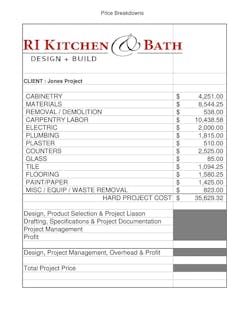I am the president of RI Kitchen & Bath, a design/build remodeler in Warwick, R.I. We first opened our doors in 1989, and today have 30 employees and a large showroom.
Throughout RIKB’s history, we have, for the most part, been a fixed-price-per-project company. But over the past few years, as the internet became a much larger part of the buying cycle, we started getting more questions from potential clients. They wanted greater detail on labor and materials costs, and would ask specific questions about where their money was going. It was not something we were prepared to address.
Introducing Transparency
So, in response to our clients, we started to look at the idea of transparency. We began the journey about two years ago, and have come a long way since then. It’s still evolving though, and the process is almost entirely client driven. To succeed in this business, you need to change and adapt with the market. If you aren’t willing to do that, prepare to become irrelevant.
We started by asking ourselves, “How can we help homeowners make a decision without showing everything?” Opening the books to clients has been an industry fear for a long time. We don’t want a homeowner’s mindset to be, “This company is trying to make a profit on my project.” Yet that is the reality-—along with doing a great job and providing outstanding service, of course.
We began by breaking our estimates down by category, including plumbing, electrical, and so on. But we were still getting questions like, “How much is that sink I picked?” and “What is the square footage cost of my tile?” Our clients were forcing us to become even more transparent.
Our salespeople were hesitant at first. They didn’t want to be open about our costs and perceived it as a possible friction point in the process with clients. We had a lot of discussion about that and over time, the team became more comfortable with this new way of presenting information. A good percentage of our staff are Millennials, and as part of that generation, they are used to getting instant information. It helped when we explained that clients want the same thing.
The sample estimate shows a detailed RIKB price breakdown. Some of the information, such as project management and profit is proprietary, but would be included in an actual bid.
How to Share?
Every company runs their books differently in terms of what’s above the line, and what’s below. Some consider a production manager and/or company vehicles as production costs while others put those expenses under salary and overhead. When it comes to transparency, a lot of companies struggle with this. You can go down a rabbit hole with people questioning how you run your business. You have to decide how many details you want to share.
Showing Our Company’s Value
In addition to transparency in estimating, we’ve also begun showcasing RIKB’s value in concrete ways. For example, before visiting a client’s home, we first bring them into our headquarters and give a tour. For us, this is an appropriate way to set the stage. The goal is to give them a clearer understanding of what we do.
We introduce them to everyone, and they can see how many people’s efforts go into creating their project. We also show them the warehouse where we receive and inspect the products. If they decide to go forward with us, we want them to know that they are paying for a company with a large physical presence and designers. That’s one of the biggest things about design/build overall is people’s lack of understanding about what that means. They lump us in with a contractor, and while we are a contractor, we’re also much more.
The Effects of Transparency
Since implementing this, we’ve found that people have a greater appreciation for what we do. They always thank us and say that they now understand our business model and pricing. This way, we gain their trust at the very beginning of the project, rather than working to have it by the end.
Becoming more transparent has been an asset for the salespeople as well. They are now able to build value by creating more trust, which has increased our close ratio has increased.
This is one of the most freeing things we could have done as a company, and it’s still a work in progress. I’m excited to see where this road takes us over time.
About the Author

Tonya Donahue
Tanya Donahue is the preisdent of Rhode Island Kitchen & Bath.
